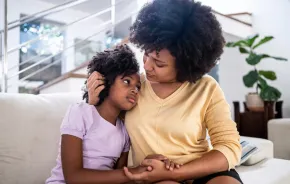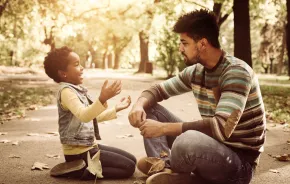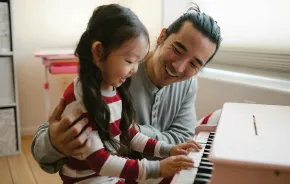
Last Sunday, I did something that felt very strange. I drove to my 85-year-old father’s house in a Seattle suburb to pick up a jacket I had left there several weeks ago. Normally, I’d come in, give him a hug and stay to chat for as long as I had the time and he had the energy.
That day, though, I just waved at him and my stepmother through the screen door of their house and told them I loved them. I retrieved the jacket from the fence outside the house where they had carefully hung it, and left. Because in the era of COVID-19, keeping your distance — painful as it may be — is love.
In the mere weeks since our lives have been upended, I have never felt so connected and disconnected in my life. I’m on a neverending text thread with mom friends that keeps me laughing, crying and sane. I’ve FaceTimed with high school friends for the first time in years, feeling strangely unrushed (nowhere to be! Ever! Again!). I restarted a Words With Friends habit with an old friend.
Meanwhile, my tech-savvy 10-year-old has wasted no time in virtually connecting with all sorts of real-world friends. He’s merging calls on my iPhone while playing a video game with friends, and FaceTiming like he was born doing it. He asked about how we might virtually watch a movie with friends even before I knew that Netflix had released a party app.
But all this connection also feels chaotic. So many apps. So many ways to video-chat. So many ways for my son to steal my phone while I’m trying to get work done at home! And yet, I cannot drive up to my dad’s house and just hang out. To help myself, and you, I gathered some ideas for ways to connect that are especially good for the easily overwhelmed.
Set up a plan
In my house, we have a list going of people to keep in touch with; it includes always-in-the-loop friends as well as people we’re a little concerned about: my Midwestern aunt who’s a new resident in an assisted living facility that’s inching towards lockdown; the elderly neighbor who says he doesn’t need anything; a friend who recently lost her dog and lives alone. The goal is to reach out to one person a day, in rotating fashion. I also already have a weekly conference call set up between my sisters and my father that seems more important than ever.
Send a postcard — via the app
Letters seem safe, according to some sources, but if you want to be absolutely sure that you’re not transmitting anything via old-school mail, you could have kids write letters and then send pictures of them through email. You can also send postcards by app; just choose a photo, type a note and ship it without ever touching anything. My favorite for ease is Postcardly (about $2 a postcard), but other apps abound, from Touchnote, which has many caption and sticker options but is more expensive (about $3 a postcard, with an annual plan option) to Postagram, another $2 option.
Kid postal service
Last Friday, a friend of my son’s left him an envelope with a short letter and a treasured mini-figure. My son was ecstatic. The next day, my son reciprocated with a short note and three mini-figures. Now, we are talking about having the kids deliver notes and packages to each other once or twice a week, or having a neighborhood spot where they leave items. Bonus: You can work this into the day’s learning plan. (Best practice is, of course, to wipe everything down once you get it, or let it sit for several days.)
Use Marco Polo to send a video postcard
Video chatting is wonderful, and there are a million ways to do it — What’s App, Zoom, FaceTime, Facebook Portal, Skype, Google Hangout — but you also have to be available at the right time and ready to talk. An introvert’s nightmare, in other words. A fun alternative is to download the brilliant Marco Polo app and exchange video postcards with your friends and family. You can leave a video message whenever you want (hello, insomnia), and they can look whenever they want. It’s easy to use, really fun for kids to try (there are filters, emojis and editing tools) and an introvert’s dream.
Play a game
An unsurprising fact I have observed: Ten-year-old boys don’t have a lot to say to each other on the phone, until they start playing a video game online together. Then they never shut up. Games help connect us in real life, and in virtual life as well. But it doesn’t just have to be video games. Tap friends and family members to play chess online (try Chess by Post), Scrabble (Words With Friends), and many other games. Certain board games also lend themselves well to video conferencing, such as Guess Who and Battleship. Just make sure each kid has a copy of the game.
Hang out on the phone
Remember middle school, when you would call a friend and talk for hours? You can still do that. A friend of mine “spent” her entire evening with her elderly mother via Skype: She cooked dinner while her mother watched, cat in her lap; they told stories and even sang songs, for several hours. It was lovely, she says, and almost, kind of, normal.
Neighborhood connection
Poignant videos have been circulating of Italians singing together from their balconies, a beautiful testament to resilience, culture and community spirit. Similar movements have already started in Seattle, through Facebook groups such as Sing Your Heart Out Seattle (which organizes weekly Sunday sing-alongs) and Seattle Sing It Loud (8:30 p.m. porch sing-a-longs). In West Seattle, someone chalked up a two-block long obstacle course for children (or grown-ups) to complete. In other neighborhoods, people are turning Little Free Libraries into Little Free Pantries. Many of us are figuring out ways to stay in touch with elderly/vulnerable neighbors to deliver groceries or other essentials.
These ideas won’t be a fit for every family or every neighborhood, but perhaps you can find another visible (or audible) way to stay in contact. Because in this most uncertain of uncertain times, the one thing that I know is that connection — by distance, of course — is everything.











